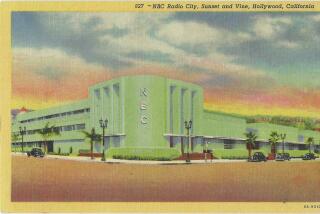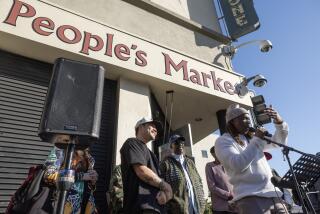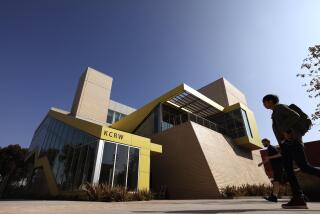KSCA Fans Fear New Owner Will Touch Dial
The expected sale and format change of KSCA-FM (101.9) in Los Angeles isn’t a done deal. But already fans of the so-called adult alternative outlet, recording artists who get played on it, record executives who rely on it and rival radio programmers in this competitive market--not to mention the station’s staff--are preparing for life without it.
“Some of us think this is the only station there is,” Melinda Hughes of Van Nuys wrote in a pleading letter to KSCA owners Gene and Jackie Autry.
The letter was part of a campaign Hughes is spearheading among listeners to try to stop the sale of the station to the Spanish-language media giant Heftel Inc. in Dallas. Heftel already owns two top-rated Latin music stations in L.A.: KTNQ-FM and KLVE-FM. An agreement for Heftel to assume operation of KSCA, and eventually to purchase it, is expected shortly after the New Year, to take effect several weeks later.
“I’ve been listening to radio for 35 years,” Hughes, 39, explained passionately at a recent event hosted by KSCA where she was enlisting other letter-writers. “I really loved some of them, but I’ve never bonded with one like this.”
That’s not an uncommon sentiment among the listeners who have tuned in regularly since KSCA went on the air on July 1, 1994. Hughes had no trouble collecting letters from fellow fans that night, and the station (and The Times) has been deluged by mail, faxes and e-mail from listeners looking for ways to preserve the programming.
Under program director Mike Morrison, KSCA has championed a mix of folk-based and classic-rock-rooted artists both old and new, from Sting, Elvis Costello and Joni Mitchell to Joan Osborne, Alanis Morissette and the Wallflowers. The format, sometimes called Triple A (for Adult Album Alternative), took its clues from such noncommercial sources as public station KCRW-FM (89.9) in Santa Monica and tried to make it work in the highly competitive commercial radio world.
“This is not a short-term fix kind of format, not an immediate mass appeal format,” Morrison says. “It doesn’t generate big numbers quickly, and that wasn’t our goal when we started. Loyalty and consistency were higher priorities.”
Similar stations have been hits in other markets, such as KFOG-FM, No. 1 in the Bay Area among young adults. Indeed, KSCA’s ratings have been higher than the frequency’s previous formats--easy-listening KLIT and, before that, the short-lived KEDG, a more loosely structured attempt at eclecticism. But KSCA has not climbed into the Southland market’s Top 25, generally hovering instead around a 1.5 rating.
Still, if the audience hasn’t been great in quantity, there’s no question about its quality both in terms of its devotion and, with upscale baby boomer demographics, its desirability to potential advertisers. Among L.A. stations, KSCA draws the largest number of listeners with incomes of more than $100,000.
“They are a very small but loyal audience, and one should underline loyal,” says Tommy Edwards, program director of KCBS-FM, known as Arrow, which may stand to pick up some of the KSCA audience with its classic-rock emphasis.
But “once KSCA changes format, a sizable number of those listeners might not want to go to other radio stations at all,” adds Edwards.
If listeners do drift to existing stations, others likely to benefit include the younger-skewed KROQ, the eclectic KCRW (though much of its programming is not music), the rock-oriented KLOS and, with a combination of current hits and ‘70s-’80s nostalgia, KYSR (Star 98.7).
What the listeners really want to hear, though, is KSCA. As word got out last month that the station was to be sold, reports started that the staff already was exploring the possibility of taking the format--lock, stock and playlist--to another L.A. frequency.
That’s not unprecedented (classical station KFAC-FM moved up the dial several years ago to its current KKGO locale), but it is highly unlikely in this case. The station’s ratings have been good enough to raise its value but not good enough to save the format--especially to the tune of the $50 million to $100 million that it takes to buy a station in this media-centric market. Morrison would not comment on the possibility.
Many in the industry hope that the end of KSCA will not be viewed as a failure of Triple A in L.A. The sale, they say, is not due to poor ratings but to the Autrys’ ongoing divestiture of holdings.
The consensus is that management, anticipating the sale, did not commit to the kind of promotional activities that could have raised the station’s profile. (Neither station representatives nor Heftel would comment on the pending sale.)
“If we’re judging on the ratings, we need to be harsh: It has not been successful,” says Jeff Pollack, an L.A.-based programming consultant to more than 100 stations nationwide, though with no business connection to KSCA.
“But from the impact of selling records and of the music industry embracing it and the listeners, the station’s presence is much wider than reflected in the numbers,” Pollack added. “It will be missed, because it provided a viable outlet for a substantial stable of artists. We need that diversity.”
“Every major label talks about how the idea is to stay with artists and build careers,” says Warner Bros. Records President Steven Baker. “That’s what stations like this do that others don’t.”
Bob Bell, new release buyer for the Wherehouse chain of stores, echoes that. Most stations “don’t get behind a song until it’s a proven hit elsewhere,” Bell says. “KSCA gives those artists a shot. That largely baby boomer audience may not be instant buyers of something they hear, and the nature of the format is not to play a record 40 times a week, so it takes a while for people to hear an artist enough times that they know they want to make a purchase. But when they find something they like, they really like it.”
Artist manager Ron Stone points to several clients who rely on this airplay to reach their fans. “Bonnie Raitt transcends the format, but she’s sold lots of records from it. And during Tracy Chapman’s recent resurgence, we went for four or five months where this was the only format playing her record, and we sold lots of records.
“And Lyle Lovett exists on L.A. commercial radio only on KSCA. He doesn’t have hit singles, but he has a big audience.”
The most dramatic Triple A success story may be Joan Osborne who, many say, owes her millions of record sales directly to the format.
“You probably would have never heard of her, or Jewel, on other radio stations if they hadn’t been on Triple A first,” says Stone, who does not manage either artist.
Singer-songwriter Suzanne Vega, a KSCA staple, concurs. “I know I went out and bought Joan Osborne’s album because I heard her song ‘St. Teresa’ on KSCA long before she was a hit,” Vega says. “Everyone I know listened to [KSCA] and talked about it.”
Morrison remains confident that Triple A could make a larger impact in L.A., whether continuing where it is or moving to another station.
“It’s not an issue of quantity vs. quality,” he says. “There are plenty of examples of things that are high quality that make a lot of money: ‘Seinfeld’ or Alanis Morissette, for example. I don’t think this is easily summed up as such a black and white situation.”
More to Read
The biggest entertainment stories
Get our big stories about Hollywood, film, television, music, arts, culture and more right in your inbox as soon as they publish.
You may occasionally receive promotional content from the Los Angeles Times.










